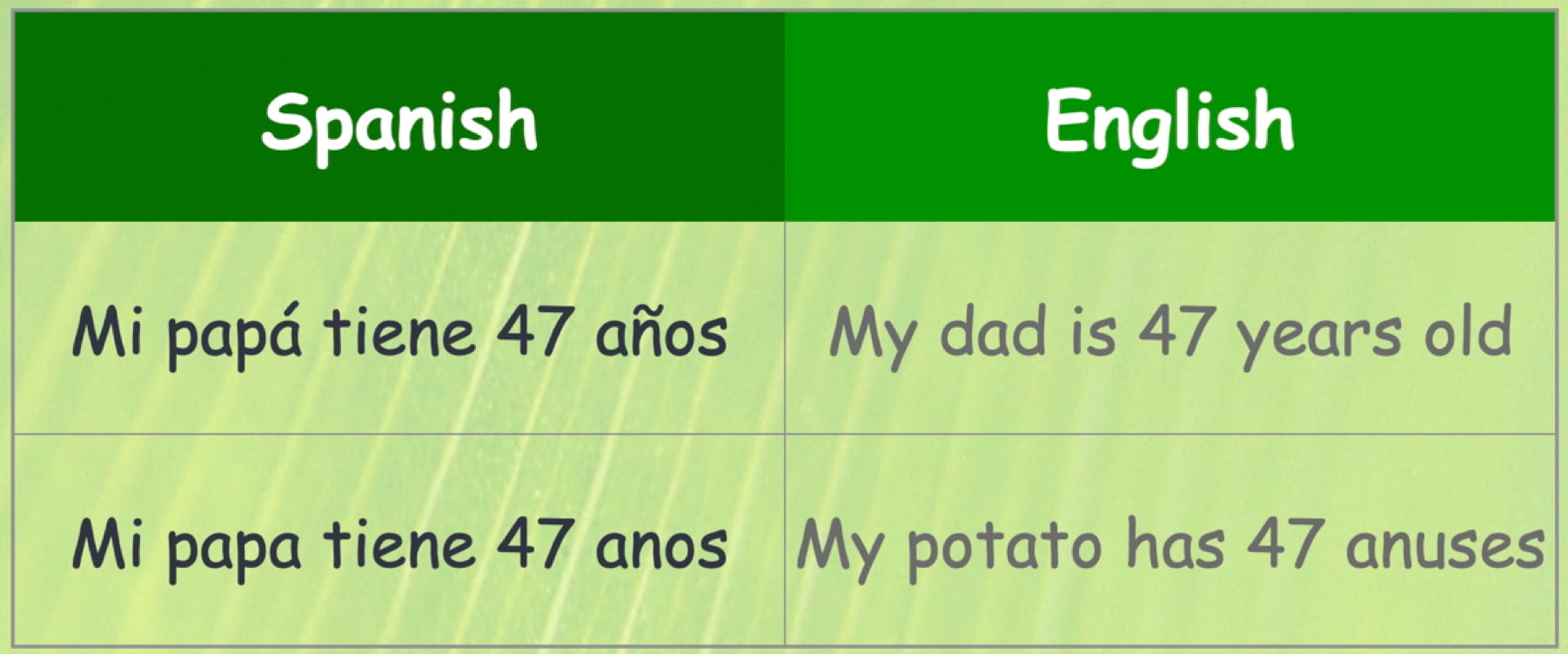Articles
When I was a student in high school, I had a Maths teacher named Ralph Cooper – “Mr Cooper” to his students, of course. We always knew when he was getting angry (which was several times every lesson), as his face turned bright red, his breathing became slow and deep, and he stood silently at the front of the classroom, staring at us in silence while slowly rolling a piece of chalk back and forth in the palm of his open, upwardly turned hand.
These days, we refer to this behaviour as ‘body language’. Language and communication are not the same as each other. Language is based on vocabulary and strict rules of grammar (yes, even nowadays) – that is why “Jack hit Jill” is not the same as “Jill hit Jack”. These precise rules of language may be subtle, which explains the difference between the Spanish sentences “Mi papá tiene 47 años” (My dad is 47 years old) and “Mi papa tiene 47 anos” (My potato has 47 anuses).

Imagine two situations , both of which occur in a meeting of your school board:
Situation 1: You are bored with the discussion and, while the Chair is looking away, you catch someone’s eye across the table and make a yawning gesture by putting your hand to your mouth.
Situation 2: You are trying to look interested in what a board member is saying and to your horror you find you are starting to yawn.
Both yawns communicate information, and might be termed ‘body language’, but only the first should really be described as language, because the gesture was intentional.
Board meetings can be notorious for the mis-communication that occurs, especially when well-meaning passions cloud a person’s ability (or willingness) to consider other people’s viewpoints. In extreme cases, respect for others can break down and heated rhetoric might itself become an issue when attendees fear that their words are falling short of the intensity of their feelings. The American writer Ralph Waldo Emerson once wrote that to speak is to "roast your marshmallows on Vesuvius" – that is, our language is just a pale reflection of the fire within us.
This potential for mis-communication has expanded enormously with the increasing use of conducting meetings online through platforms such as Zoom, Webex, Teams and GoTo Meetings. Even setting aside concerns about poor bandwidth and distracting backgrounds, online board meetings lack spontaneity because of repeated tiny time lags and, more significantly, the loss of much of the body language and eye contact that most people take for granted – and rely upon – to communicate effectively.
There are commonly accepted cultural rules of conversational communication. For example, when I was Head of an international school in Hong Kong, and my board’s membership consisted entirely of local Hong Kong Chinese people, I soon learned that the conversational dynamics were vastly different from my experiences elsewhere. When an issue was being discussed, it was usually the younger members who would speak first, and a range of opinions would be expressed. As the discussion continued, more senior members would agree with the emerging consensus, adding some additional weight to the arguments. We knew the discussion was drawing to a close when one or two of the most senior members of the board (who had usually consulted together by telephone prior to the meeting) spoke quietly to the hushed room and revealed the “correct” outcome, at which point everyone around the table would nod in agreement.
In most societies, there are widely (but not universally) recognised rules for conversing, especially regarding the protocols for interrupting other people, or correcting other people’s comments.
To take an example from everyday life (as opposed to the more heavily structured situation of a board meeting), when someone asks you for the time, you might reply by saying “it’s half past ten” when it is actually 10:28 or 10:32. This helps us understand that some conversations occur in a precise context, which others take place in an imprecise context. In an imprecise context, it is acceptable to round off the time within, say, three or four minutes. On the other hand, in a precise context, such as counting down to New Year’s fireworks (or in every conversation with my eldest son), it is expected that you would be very particular in expressing accuracy.
Board meetings are somewhat contrived conversation environments. The rules of conversation are seldom articulated explicitly, which means every member may well come to every meeting with different underlying assumptions about what is acceptable and what is not. It is easy to see how unintended misunderstandings can arise in such situations, especially if the unwritten rules for correcting others hang ambiguously over the meeting.
Some school boards fall into the habit, or the comfort zone, of tolerating sub-optimal meeting dynamics. It may seem easier at the time to let this slide, but inevitably it diminishes the effectiveness of the board’s work and ultimately adds to everyone’s workload, especially that of the Principal.
Every board – and the school it serves – benefits from the periodic input of a well-informed, external, politically neutral critical friend or mentor.
-Dr Stephen Codrington
The information in this article is expanded in the "Board Meetings and Dynamics" module of workshops such as OSG-S1 - Board Operations as well as in the book "Optimal School Governance", which can be ordered directly through Pronins.
Our services to assist with critical friendships and leadership mentorship are outlined HERE.
You may also be interested in previous articles which are archived at https://optimalschool.com/articles.html.